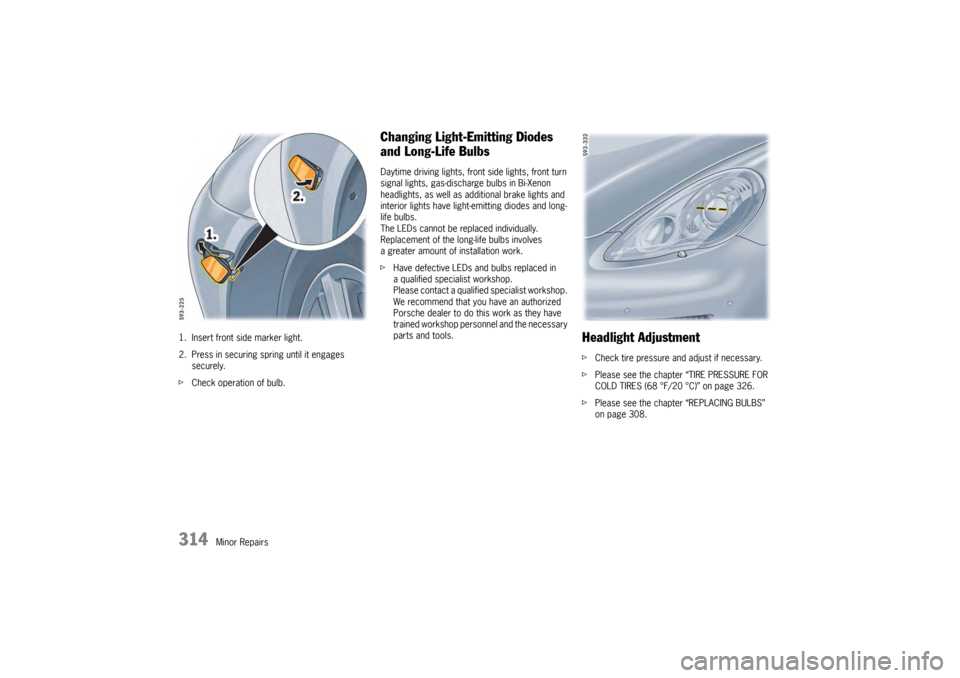2009 PORSCHE PANAMERA tire pressure
[x] Cancel search: tire pressurePage 291 of 343

Minor Repairs
289
– second two-digit code means tire size.
– third four-digit code means tire type code.
– fourth four-digit code means date of manufacture.
If, for example, the last four numbers read
1204, the tire was produced in the 12th week
of 2004.
C – Tire ply composition and material
The number of layers in the tread and sidewalls
and their material composition.
D – Maximum permissibl e inflation pressure
The maximum permissible cold inflation pressure
to which a tire can be inflated.
f Do not exceed the permissible inflation
pressure.
E – Maximum Load rating
The maximum load in kilograms and pounds can
be carried by the tire. If you replace tires always
use a tire that has the same maximum load rating
as the factory installed tire.
F – Radial
The identification indicates if the tire has radial
structure.
G – Term of tubeless or tube tire
Identification for tubeless tires. Speed code letters
The speed code letter
Y indicates the maximum
permitted speed for the tire.
This code letter is shown on the tire sidewall.
Tip on driving
Tires with a maximum speed rating that is lower
than the specified maximum vehicle speed may be
mounted only if they bear an M+S identification on
the tire sidewall.
f Please note that in addition to snow tires,
all-season tires are also subject to speed limits
and bear this identification.
G- Rim width in inches
H - Rim-flange contour code letter
I - Symbol for drop-center rim
J - Rim diameter in inches
K -Double hump
L - Rim offset in mmInscription on alloy wheelsThe information is inscribed on the back of the
spokes near the tire valve.
T
= up to 118 mph (190 km/h)
H = up to 131 mph (210 km/h)
V = up to 150 mph (240 km/h)
W = up to 167 mph (270 km/h)
Y = up to 186 mph (300 km/h)
(Y) = up to 186 mph (300 km/h) as for Y tires.
Speeds of more than 185 mph
(300 km/h) are also possible at
a maximum tire load capacity of 85 %
(confirmation from tire manufacturer
required for speeds of more than
185 mph (300 km/h)).
Page 294 of 343

292
Minor Repairs
Screw in one assembly aid on vehicles without PCCB8. Screw in assembly aids instead of wheel bolts.
Caution!
Risk of damage to brake discs.
f Always screw in the assembly aids when changing a wheel.
Screw in two assembly aids on vehicles with PCCB9. Remove the remaining wheel bolts.
10.Take the wheel off and put a new wheel on.
fPlease see the chapter “WHEEL BOLTS” on
page 293.
11.Insert wheel bolts and tighten by hand.
12.Remove assembly aids and screw in remaining wheel bolts.
Initially tighten bolts only slightly in
diagonally opposite sequence so that
the wheel is centerd. 13.Inflate the tire if necessary.
f
Please see the chapter “TIRE PRESSURE FOR
COLD TIRES (68 °F/20 °C)” on page 326.
14.Lower the vehicle fully and remove the jack.
15.Tighten wheel bolts in diagonally opposite sequence.
Immediately after changing a wheel, use
a torque wrench to check the prescribed
tightening torque of the wheel bolts
(160 Nm/118 ftlb.).
Note on operation for vehicles with Tire
Pressure Monitoring
f On vehicles with Tire Pressure Monitoring, the
settings on the multi-function display must be
updated after the wheel change.
f Please see the chapter “TIRE PRESSURE
MONITORING (TPM)” on page 127.
Page 295 of 343

Minor Repairs
293
Wheel Bolts fAlways clean the wheel bolts before fitting.
f Wheel bolts must not be greased.
f Replace damaged wheel bolts.
Only use genuine Porsche wheel bolts
assigned especially to this model or wheel
bolts of similar quality that have been
manufactured according to Porsche
specifications and production requirements.
Tightening torque
Tightening torque for wheel bolts: 160 Nm
(118 ftlb.) .
Security wheel boltsThe adapter (wrench socket) for the security
wheel bolts is stored in the tool tray under the
luggage compartment floor.
fIf the wheels have to be removed at the
workshop, do not forget to hand over the
socket for the security wheel bolts along
with the car key.
f To loosen or tighten the wheel bolt with anti-
theft protection, the adapter must be used
between the wheel bolt and the wheel
bolt wrench.
f When positioning the wrench socket, ensure
that it engages fully in the teeth of the
wheel bolt.
Flat Tire 1. Stop the vehicle as far away from the driving lane as possible.
The vehicle must be parked on a firm and flat
surface offering adequate grip.
2. Switch emergency flasher on.
3. Apply the parking brake.
4. Put the vehicle in 1st gear or move the PDK selector lever to position P.
5. Straighten the front wheels.
6. Remove the ignition key, or the control unit on vehicles with Porsche Entry & Drive, in order to
lock the steering and pr event the engine from
being started.
7. Get all passengers to leave the vehicle.
8. Set up the warning triangle at a suitable distance.Filling in tire sealantThe tire sealant and compressor with pressure
tester can be found in the tool tray under the
loadspace floor in the luggage compartment.
The tire sealant can be used to seal small cuts,
especially in the tire tread.
Sealing the tire with the tire sealant is only an
emergency solution so you can drive to the
nearest workshop. Even if the tire is air-tight,
Page 297 of 343

Minor Repairs
295
5. Screw filler hose B onto the filler bottle.The filler bottle is now open.
6. Unscrew valve cap from the tire valve F.
7. Remove valve insert E from the tire valve with
valve turner D.
Keep the valve insert in a clean, dry place.
8. Remove plug C from the filler hose B.
9. Push filler hose onto the tire valve.
10.Hold the filler bottle higher than the level of the
tire valve and squeeze it forcefully until the
bottle is completely emptied into the tire.
11.Pull filler hose off the tire valve.
12.Twist the valve insert firmly into the tire valve using the valve turner.
13.Connect the compressor to a vehicle plug socket and inflate the tire to at least 37 psi
(2.5 bar).
If this tire pressure cannot be reached, the tire
is too severely damaged. You must not
continue driving with this tire.
14.Screw valve cap onto the tire valve. 15.After driving for approx. 10 minutes, check the
tire pressure.
If the tire pressure is less than 22 psi (1.5 bar),
do not continue driving.
If a value of more than 22 psi (1.5 bar) is
indicated, correct the pressure to the
prescribed value.
f Please see the chapter “TIRE PRESSURE FOR
COLD TIRES (68 °F/20 °C)” on page 326.
16.Please contact a qualified specialist workshop. We recommend that you have an authorized
Porsche dealer to do this work as they have
trained workshop personnel and the necessary
parts and tools.
f Please also make sure to follow the separate
instructions for use for the tire sealant.
Note on operation for vehicles with Tire
Pressure Monitoring
f The settings for Tire Pressure Monitoring must
be updated on the multi-function display after
filling the tire with sealant.
f Please see the chapter “OVERVIEW OF
WARNING MESSAGES” on page 152. Care instructions
After drying, any sealan
t that emerges can be
peeled off like a film.
Warning!
Risk of accidents, resulting in serious
personal injury or death.
f Have the tire replaced by a specialist
workshop as soon as possible.
Inform the specialist workshop that the tire
contains sealant.
f Avoid hard acceleration and high cornering
speeds.
f Observe the maximum speed of 50 mph
(80 km/h).
f Always observe the safety and operating
instructions, which can be found in the
separate operating instructions for the sealant and on the compressor.
Page 302 of 343

300
Minor Repairs
Fuse box in right side of dashboard
36 Not used
37 Not used
38Front cigarette lighter,
luggage compartment socket 20
39 Seat adjustment, front left
without memory 30
40 RHD, center console sockets,
glove box 20
41 PSM control unit 10
42 Interior light in roof console 7.5
43 Not used
44 Not used
45 Not used
46 Not used
47 Slide/tilt roof 30
48 Windshield wipers 30
49 Engine control unit 5
50 Not used
51 Seat adjustment, front left
with memory 30
52 Seat adjustment, rear left 20
53 Circulating pump 10
54 Rain sensor 5
55 Not used
56 Not used
57 Air-conditioning system fan 40
No.
Designation A
No.Designation A
1 Tire Pressure Monitoring control unit 5
2 Not used
3 Seat heating, front 30
4 Seat heating, rear 30
5 Seat adjustment, rear right 20
6 Not used
7 Not used
8 Seat adjustment, front right
with memory 30
9 RHD, electric parking brake button 5
10 LHD, handset, mobile phone charger
RHD, steering column adjustment 5
15
11 RHD, PDK control unit 25
12 LHD, telephone 5
13 Not used
14 Xenon headlight, right 15
15 Not used
16 RHD, diagnostic socket 5
17 PSM control unit 5
18 LHD, air conditioning, sun sensor
RHD, PDK control unit,
clutch sensor 5
19 Garage door opener 5
20 Air bag control unit 7.5
21 Advanced air bag, occupant sensing 5
22 Steering column switch 5
23 Adaptive cruise control (ACC) 5
24 Seat ventilation, front seats 7.5
25 Seat ventilation, rear seats 7.5
26 Not used
27Front center console socket,
Rear cigarette lighter 20
28 Seat adjustment, front right
without memory 30
29 LHD, rear center console socket,
socket in glove box,
socket in large rear center console 20
30 Not used
31 Coolbox 15
32 Rear Seat Entertainment 7.5
33 Right-hand drive vehicles only:
Turn signal, rear right
Marker light, front left
Low beam headlight, right
High beam headlight, right
Side turn signals, front
Cornering light, front left
Ignition lock
Two-tone horns
PSM
Starter relay
Emergency flasher switch LED
Ignition lock lighting
Turn signal, front left/right
Footwell lights
Ignition lock anti-removal lock
Power steering control valves 30
No.
Designation A
Page 307 of 343

Minor Repairs
305
Replacing the batteryThe service life of the battery is subject to normal
wear; it depends greatly on care, climatic
conditions, and driving conditions (distances,
loads).
f Only use an original Porsche battery, with the
correct part number, as a replacement. Only
this battery meets the spec ific requirements of
the vehicle.
f Please observe the disposal instructions for
batteries.
Putting vehicle into operationAfter the battery is connected or after a fully
discharged battery is charged, the PSM warning
light lights up on the instrument panel and
a message appears on the multi-function display
in the instrument panel to indicate a fault.
This fault can be corrected with a few
simple steps:
1. Start the engine. To do this, turn the igni tion key or the control
unit (on vehicles with Porsche Entry & Drive)
to ignition lock position 2, twice .
2. With the vehicle stationary, perform a few steering movements to the left and right and
then drive a short distance in a straight line
until the PSM warning light goes out and the
message is erased from the multi-function
display in the instrument panel.
3. If the warnings do not disappear, then:
Drive carefully to the nearest authorized
Porsche dealer to have the fault corrected.
4. After the warnings go out: Stop the vehicle in a suitable place.
5. Store the end position for the power windows. For information on storin
g the end positions for
the power windows:
f Please see the chapter “STORING END
POSITION OF THE DOOR WINDOWS AFTER
CONNECTING THE VEHICLE BATTERY” on
page 88.
6. Teach tires on vehicles with Tire Pressure Monitoring.
For information on teaching the Tire Pressure
Monitoring system:
f Please see the chapter “TIRE PRESSURE
MONITORING (TPM)” on page 127.
7. Store end position on vehicles with a slide/ tilt roof.
For information on storing the end position for the
slide/tilt roof:
f Please see the chapter “STORING END
POSITION OF THE SLIDE/TILT ROOF” on
page 90.
Page 316 of 343

314
Minor Repairs
1. Insert front side marker light.
2. Press in securing spring until it engages
securely.
f Check operation of bulb.
Changing Light-Emitting Diodes
and Long-Life BulbsDaytime driving lights, front side lights, front turn
signal lights, gas-discharge bulbs in Bi-Xenon
headlights, as well as additional brake lights and
interior lights have light-emitting diodes and long-
life bulbs.
The LEDs cannot be replaced individually.
Replacement of the long-life bulbs involves
a greater amount of installation work.
fHave defective LEDs and bulbs replaced in
a qualified specialist workshop.
Please contact a qualified specialist workshop.
We recommend that you have an authorized
Porsche dealer to do this work as they have
trained workshop personnel and the necessary
parts and tools.
Headlight AdjustmentfCheck tire pressure and adjust if necessary.
f Please see the chapter “TIRE PRESSURE FOR
COLD TIRES (68 °F/20 °C)” on page 326.
f Please see the chapter “REPLACING BULBS”
on page 308.
Page 317 of 343

Minor Repairs
315
Adjustment
The adjustment is made with the vehicle ready to
drive and the fuel tank completely filled.
The driver's seat must be loaded by a person or a
165 lbs. (75 kg) weight and the tire pressures
must meet the prescribed values. After being
loaded, the car must be rolled a few meters so
that the suspension can settle.
For checking the headlight adjustment, the
vertical position of the cutoff of the lowbeam (see
fig.) has to be projected on a vertical screen (wall)
in distance of 24.6 ft. (7.5 m) from the front lens
of the headlamp.The correc t position of the cutoff
is 3.0 in. (7.5 cm) at 24.6 ft. or 7.5 m (0.4°)
below a horizontal line, x cm from ground to the
center of the headlamp lens. Lateral adjustment of the headlights should be
carried out at a specialist workshop with an optical
adjustment unit.
Distance
Visual aim shall be performed at not less than
24.6 ft. (7.5 m) (this value is a rounded down
conversion from the 25-f
oot distance typical of
field aim using a screen). The 24.6 ft. (7.5 m)
distance is measured from the headlamp lens to
the viewing screen.
Floor
The surface upon which the vehicle rests is flat
and approximately level.
Screen
The screen upon which headlamp beams are
projected is perpendicular to the floor and the
vehicle's longitudinal axis, flat, uniformly light in
color, unobstructed, and wide and high enough to
accommodate the vehicle beam patterns to be
aimed.
The screen should be wide enough to provide at
least 3.3 ft. (1 m) of space outboard of the
vehicle's headlamp spacing.